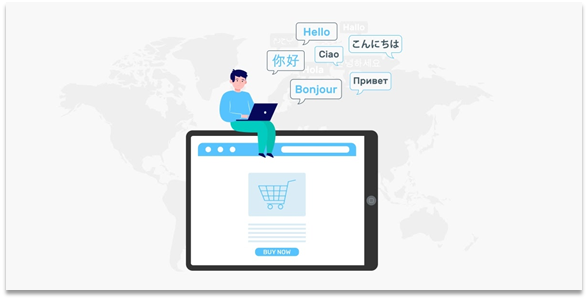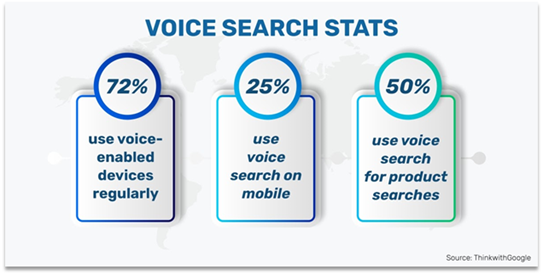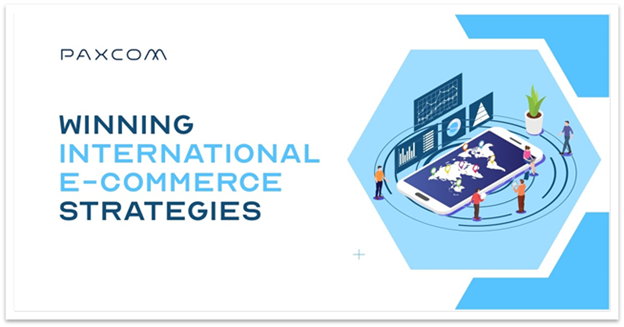In eCommerce, the world is literally your oyster. The internet has made it possible for people in different countries to do business together. There are no longer any limitations on who can engage in cross-border transactions, and there are no limits on the type of products or services that can be sold internationally. With worldwide eCommerce sales projected to reach 5.4 trillion US dollars in 2022 (Statista), now is the time to let yourself be entangled in the international marketplace.
As we have established, eCommerce is the future of business. But to be successful, you must first create a solid international eCommerce strategy. Let us take you through an in-depth look at how to set up and run a successful store that caters to customers from all across the globe.

Table of Contents
Here we present a guide on how to create a successful international eCommerce strategy-
1. Test the waters and pick the region
To expand internationally, you need to decide on a region. There must be so many questions in your mind, like “what will be the biggest market for my product”? Which currency should I use? ‘Which language will be helpful’? Your first step should be to have clarity of thoughts and a clear goal to align your business with a stronghold.
It is advised that you start with a small-scale test before going the whole hog and moving everything overseas. You will want to determine precisely where your customers are and how those potential customers will interact with your brand online. Doing this research can help save time and money as well as ensure that you have found the right place for your business to expand into next.
If you were looking to expand in Australia, then you would find that baby products and gardening equipment and accessories get the most traction and high sales volume, and if your product falls under the same category, then you will know which region is perfect for your expansion. Research, test the water, and then dip your toes in.
2. Keep an eye out for your competitors
Every eCommerce business must analyze its competitors. Entering a new market requires two things: competing and winning. The first step in achieving this goal is to monitor existing and potential competitors in the target country. This will enable you to understand what market level you will operate at and how they can outperform you. All these data points can help you fine-tune the international eCommerce strategy that works for you.
3. Connect with customers through localized content

There are many things to do to localize your content. Depending on the languages you want to target, it can be anything from translating product descriptions to accommodating variable pricing or shipping options and keeping updated with relevant holidays and cultures. You can hire experts who understand the nuances of localization and ensure that your translations are authentic and effective.
Your goal is to convert visitors into customers, and the one thing that you can offer is a connection. When someone is looking for an advertisement text or visiting your product page/website, they should be able to resonate with you.
Making use of the region’s popular dialect or creating a buzz during event days gets a lot of attention because people are so enthusiastic, and it also conveys that you value your customers and the communities in which you do business. Especially partaking in popular days such as Halloween, Christmas in the USA, French days (end of April to May), EL Buen Fin (November revolution in Mexico), Australian Boxing Day, Southeast Asia’s 9.9, and 11.11 days.
Look at these numbers and see how localizing your eCommerce content strategy can benefit you:
- Almost two-thirds of consumers say they are more likely to buy a product if its information is in their native language.
- 56.2% of consumers said that having information in their native language was more important than price.
- One in five Europeans says that they would rather make a purchase if the content were in their language. While Europeans are multilingual, they hold a strong preference for their native language.
(Source: Harvard Business Review)
4. Optimize for voice search and mobile

In the past few years, mobile has become ubiquitous. There are two billion smartphone users around the world, and many of them use their phones to shop online. With so much attention going to mobile devices, it is vital for eCommerce websites to optimize for mobile. This will not only increase your overall conversion rate, but also drive traffic to your website from search engines and social media.
Let’s take Amazon, for example, how they are expanding their customer base in every region by seeking vernacular offerings. Many platforms have seen massive growth in sales, with customers shopping or searching for products with voice search. 72% of people who own voice-enabled speakers use them regularly (Think with Google).
Mobile searches already account for 40 to 50 percent of all internet searches, as previously stated. As voice search technology advances, smartphones will be at the forefront of this trend. By failing to optimise the platform for mobile users, businesses will have difficulty competing for valuable search results.
5. Modify the Pricing Strategy
Taking into account the differences in cultures across the world, changing your pricing strategy for each country can really help boost sales. Psychological pricing is an essential international eCommerce strategy. The manner in which a price is presented is one of the most important factors influencing how people perceive it.
The digit in front or behind the decimal point can influence prices, even if they are all rounded to whole numbers. For example, some countries’ pricing ends up with zero at the end, while some countries, such as Australia and Norway, end up with ‘9’. Always tend to use local currencies and never the universal currency.
Having various payment acceptances can help you in the long run. Think about it, how do customers pay? For instance, Italy’s consumers’ preferred payment method is PayPal. Only 15% of Southeast Asians have credit or debit cards, owing in part to the fact that only one-fourth have bank accounts. In Kenya, cash is used in 94% of transactions. According to Oracle, 29% abandon carts because of not being able to find preferred payment methods. In France, card payments are widely accepted.
Developing a clear solution for this paradox is best achieved by performing A/B tests with both pricing and payment methods.
6. Identifying logistics and shipping solutions

Logistics is a complex process that involves the movement of goods from the point of origin to the point of consumption using different methods of transport. Also, keeping in mind the customers’ shipping expectations. Like in the USA, consumers expect delivery within two days, while in France, 24% expect overnight shipping, and 85% of Germans prefer home delivery over pick-up points. (WpEngine).
When expanding globally, there are certain limitations. If your selling region is in the northwest, language could be a barrier, roads could be narrow for transportation, and it may require additional costs to deliver in those areas. That is why having proper communication is the key to avoiding all the downfalls.
Consider having a local warehouse and hiring local staff to have a competitive advantage over other cross-border sellers. If you are an omnichannel seller, decide whether you will require software tools to offer alerts on stocks? Do you need software for seamless integration? With so many tools available, it can be tough to make a decision.
But remember, customers are your priority, and almost 60% of them abandon carts if the delivery cost is too much (Baymard Institute). You can take the help of eCommerce experts to walk you through the process and help you with automation for a seamless journey.
7. Develop marketing strategies that are tailored to your audience

The type of eCommerce marketing plan you select depends on your brand and how it is perceived. Are you a global brand, or do you want to enter new markets with an individualized message? Whether your goal is to develop a distinct global brand or create targeted localized campaigns, make sure that the marketing strategies align with your product’s competitive advantage.
To begin with, you need to research where your customers spend the most time. In the UK, people start their product search on Google, while most Americans start their search on Amazon and Europeans on eBay.
Depending on your target audience and region, you need to invest in marketing activities, whether that is using AMS, influencer marketing, or banner ads. Also, to have a different promotional international eCommerce strategy depending on the cultural, festive season. Offering deals and discounts on Black Friday, Thanksgiving, Christmas. It all requires strategic planning.
Paxcom can help you create a robust marketing strategy and promotional planning which covers everything from creating deals and offers, brand days, and brand weeks participation. We can also help brands select the right media assets for better visibility on the platform. Along with that, we also help businesses do a successful joint business partnership with other brands and in regional activation for enhanced visibilities.
8. Handle International Returns
Returns are an inevitable part of the eCommerce process, especially if you sell internationally, and you should have clear return policies in place as well as a solid understanding of how to handle them, as poor handling can lead to customer walkouts.
Apart from that, fulfillment centers can also be helpful in handling product returns, or you can use omnichannel software, which can also help with the same along with product and order management.
Partnering with a logistics service provider can help you manage the inbound and outbound of your inventory in the country/region you want to operate in, which will help you get more orders and returns. In addition, this will also help you with faster delivery and return timelines, which will help in acquiring more customers and creating a flawless shopping experience.
9. Use automation tools to streamline all processes
International ecommerce strategy is about creating a system that enables global success at scale. It’s about taking steps to pull in localized suppliers, optimize your supply chain, and ensure you’re optimizing for local demand. In order to keep everything organized, you should consider using automation tools that will help you track down your-
- Inventory Management
- Forecasting Product demand
- Determining visibility share across all eCommerce platforms
- Ability to cater to all the reviews with NLP
You will need the correct and all possible available data for your business to run successfully. Paxcom’s channel intelligence solution and omnichannel solution can help you out with all the above points to diminish the volatility and uncertainty that may arise in international expansion.
The floor is yours
Globalization is in full swing, and as digital literacy rises, so does the number of transactions. A successful cross-border eCommerce business is not about luck or chance but about planning, preparation, and execution. The success of your international eCommerce strategy will largely depend on the level of attention you pay to these three areas.
As you consider expanding your eCommerce business into new markets, making sure that customers have a seamless experience on your site is critical. There are several ways to approach this, including creating separate sites for each region or modifying your existing site to meet the needs of consumers in foreign markets. Regardless of what route you take, it’s important that you optimize the user experience on your site so that new international customers don’t feel lost while browsing your products.
What’s Next?
Paxcom offers complete go-to-market support for the desired growth in the new potential markets, covering every aspect of the process, from acquiring the license for the region you want to sell to, to identifying the right partners in the market, to promoting and selling your product. For more details, connect with us at info@paxcom.net















